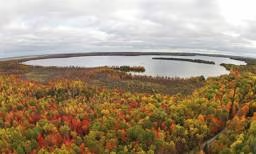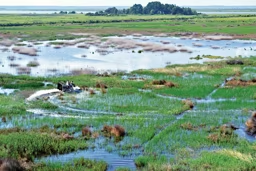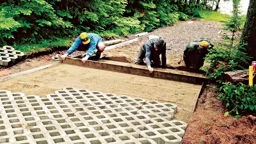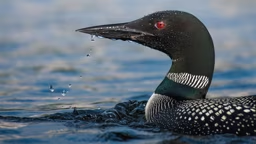Often, water quality problems in the watershed can translate to water quality problems in your lake; on the other hand, a good watershed equates to a healthy lake, with beautiful waters for you to enjoy for years to come.
Making the Next Move
Your area’s basic watershed features were established long ago. Initially, glaciers did the heavy lifting.
This is especially true in the Great Lakes states. In the northern areas of these glacial settings, soils are sandy as a result of glacial outwash. As you head south in the glaciated regions, the soils become finer in texture, dominated by silts and clays. This is glacial till, and these soils are naturally more fertile. That’s why a lake in Iowa can be naturally more fertile than a lake in New York’s Adirondacks. A fertile lake will produce more algae than a less fertile one.
Many southern and western lakes have man-made lakes or reservoirs. Glacial processes don’t factor in here. Rather, the watershed geology has been changed over millions of years by river and erosional forces. The result: variable geology, different types of soils, varying levels of natural fertility. In short, no two lakes are alike.
But, after the geology card has been played, it’s up to us to make the next move.
For millennia, snowmelt and rainwater have run off the high land and into your lake. Not only does the watershed contribute water, but also things in the water that are carried along — and some are not good.
Your lake place and your lot are likely in your lake’s watershed. And what you do on your piece of land directly impacts the health of your lake. That’s because you’re probably part of the “direct drainage” area of the watershed.
The direct drainage area is what you see when you’re out paddling a canoe or boating and you look at the the shoreline and beyond. Direct drainage is the area where runoff flows directly to the lake.
A thousand years ago, runoff was naturally “treated” before getting to the lake. Basically, water was filtered by natural vegetation and some of it infiltrated into the ground and never made it directly to the lake.
Today, our lakehomes and surrounding property are in the direct drainage watershed and some of the former natural treatment mechanisms have been altered. Protecting and improving the naturally occurring features of this direct drainage area benefits wildlife, the lake and us.
Although your lot may seem small in the context of the whole watershed, it’s an incremental thing. Improve or maintain a small piece here and there and pretty soon, cumulatively, it’s a big deal.
So what can you do with your piece of the watershed? A lot.
Less Phosphorus = Less Yuck
Phosphorus reduction in laundry detergent is now famous. It became law in the 1970s in the Great Lakes states. Although there was some controversy at that time, phosphorus limits in detergents have since been maintained in many states for many years. This means less phosphorus is going out with the wash water — and less is filtering into your lake. That’s important because algae blooms and the corresponding yuck factor are directly related to lake phosphorus content.
Research since the 1990s has found we don’t need much phosphorus in lawn fertilizer to grow grass either. More than one study has shown that in nearly all soil samples analyzed, there was already enough phosphorus in the soil to support a lawn. Reducing the use of phosphorus in lawn fertilizer will reduce the amount of phosphorus going into lakes. Some states, like Minnesota, have phosphorus fertilizer restrictions in place and other states are considering them.
Phosphorus is the middle number on a bag of fertilizer (the sequence is N-P-K or nitrogen-phosphoruspotassium). Look for the middle number to be a three or a zero.
Septic Tank Maintenance
“Septic tank” is shorthand for a septic tank/soil absorption system which is an efficient wastewater treatment alternative when correctly installed and maintained. A little water conservation, some good housekeeping rules and a few maintenance practices will keep your tank working, prevent your drainfields from clogging and help keep phosphorus from entering your lake. A checklist of maintenance and housekeeping tips includes the following:
- Divert rainwater away from the septic tank and drainfield.
- Don’t build over a drainfield (no driveways, patios, etc).
- Avoid overloading the septic tank and drainfield with too much water (water conservation can extend the life of a drainfield — which will save you expensive drainfield replacement costs and the corresponding torn-up yard).
- Limit what goes into the toilet (no cat litter, coffee grounds, paper towels, etc.) — and use the variety of toilet paper that disintegrates quickly.
- Avoid introducing harsh chemicals to the tank and drainfield.
A little yard inspection, especially during a rainfall, can pinpoint areas to fix or tweak. Maybe downspouts could go into a rain barrel or a rain garden. Water diversions using sand bars can protect your footpath from turning into a gully.
The key is to reduce the velocity of runoff — which will reduce its erosional power.
Yard Maintenance
Whoops ... some leaves fall into the lake. That’s okay; it’s been happening for centuries. But no need to push your luck. Minimize the unnatural amounts of leaves or grass clippings that end up in the lake.
Are you tending a garden and battling bugs and critters? If your household remedies aren’t keeping things under control, make sure to follow pesticide label instructions and don’t over-spray. Use the right pesticide for the right reason.
Does the lake ice push create an ice ridge along your shoreline? This might be a traditional maintenance item. But consider leaving it in place. The ridge allows runoff water to infiltrate behind the ridge rather than run directly into the lake.
Natural Landscaping
Where have all the frogs gone? Many factors are involved, but frogs need at least two acres of suitable habitat to sustain a population. In some settings, natural habitat has been eaten up by the construction of homes and the creation of lawns, roads and driveways.
Maybe you can help out the frogs and your watershed. A conventional lawn is really a low-grade open prairie. In summer, this prairie is dry and not hospitable to frogs, toads and salamanders. Reducing the amount of open prairie and replacing it with a rain garden or a tall grass prairie is amphibian-friendly and also means less mowing time. Re-establishing natural vegetation provides natural runoff treatment as well as promoting habitat for wildlife including everything from dragonflies to muskrats. This naturalization process contributes to a more pleasing lake environment.
Shoreland Buffers
Natural landscaping and shoreland buffers go hand-in-hand. A buffer 15 to 25 feet deep is enough to get water quality and wildlife benefits. The easiest way to build a buffer is to stop mowing near the lake and see what grows. Buffers can knock out sediments and take out phosphorous and other nasties before they get to your lake. When a soil particle hits the stems of tall, native grasses and brush, the particle falls to the ground. Kentucky bluegrass, however, has a tendency to bend over and is not very effective.
Another buffer benefit is privacy — passing boaters won’t be able to see every detail of your lot.
It’s worth it to invest in your watershed. It doesn’t always take money; sometimes the investment is sweat equity — but it’s an investment that pays big dividends.
Now, from that perch overlooking your lake, the natural features are working for you. You have a little extra time to enjoy the lake because you don’t have to mow all the way down to the shoreline. You’ll notice more frogs, dragonflies and other wildlife moving back to your part of the lake. Some call it relaxing, others call it passive watershed protection. Truth is: It’s both.
Steve McComas — aka “The Lake Detective” — fixes lakes for a living. He runs Blue Water Science, a lake management company.
 Tanya Bäck
Tanya Bäck 










